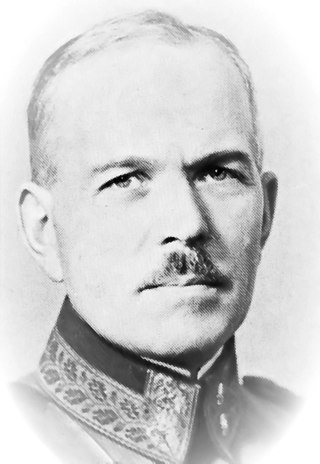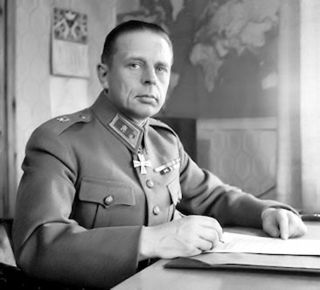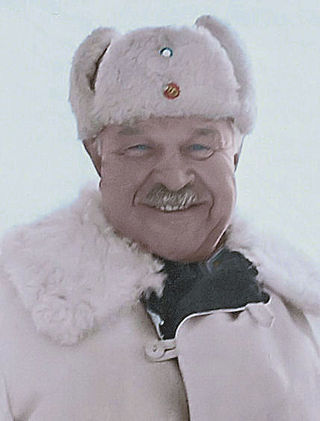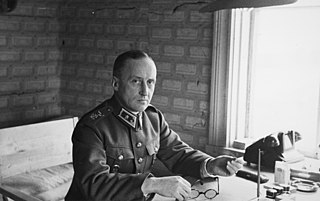| 1st Division | |
|---|---|
| 1. Divisioona | |
| Active | 1941–1944 |
| Country | |
| Branch | Army |
| Type | Division |
| Commanders | |
| Notable commanders | Paavo Paalu |
The 1st Division (Finnish : 1. Divisioona) was a unit of the Finnish Army during the Continuation War.
| 1st Division | |
|---|---|
| 1. Divisioona | |
| Active | 1941–1944 |
| Country | |
| Branch | Army |
| Type | Division |
| Commanders | |
| Notable commanders | Paavo Paalu |
The 1st Division (Finnish : 1. Divisioona) was a unit of the Finnish Army during the Continuation War.
The division was initially formed from reservists of the Lounais-Suomi military district and was intended to be used as the reserve of the General Headquarters. [1] Before the onset of the war, one of its component regiments, Infantry Regiment 14, was transferred to the Åland islands under the command of the navy as part of Operation Kilpapurjehdus. [2] The 14th regiment was replaced by Infantry Regiment 60. [3]
During the war, the 1st Division took part in the invasion of East Karelia as a component of the Finnish VII Corps that captured the city of Petrozavodsk. [4] Later in the war, the division was transferred to the II Corps. [5]

Hjalmar Fridolf Siilasvuo was a Finnish lieutenant general, a knight of the Mannerheim Cross and a member of the Jäger Movement. He participated in the Eastern Front of World War I, the Finnish Civil War, the Winter War, Continuation War and the Lapland War.

Paavo Juho Talvela was a Finnish general of the infantry, Knight of the Mannerheim Cross and a member of the Jäger movement. He participated in the Eastern Front of World War I, the Finnish Civil War, the Finnish Kinship Wars, the Winter War and the Continuation War.

Ernst Ruben Lagus, better known as Ruben Lagus, was a Finnish major general, a member of the Jäger Movement and the recipient of the first Mannerheim Cross. He participated in the Eastern Front of World War I as a volunteer of the 27th Royal Prussian Jäger Battalion, in the Finnish Civil War as battalion commander and as a supply officer in the Winter War. During the Continuation War, he commanded an armoured brigade, later division, which had a significant role in the influential Battle of Tali-Ihantala.

Karl Lennart Oesch was one of Finland's leading generals during World War II. He held a string of high staff assignments and front commands, and at the end of the Continuation War commanded three Finnish army corps on the Karelian Isthmus. He received numerous awards, including the Finnish Mannerheim Cross during his service. Following the end of the Continuation War, he was tried and convicted for war crimes relating to the treatment of Soviet prisoners-of-war.
The 6th Division was a unit of the Finnish Army during the Continuation War. Subordinated to the German XXXVI Corps, the division took part in the German-led Operation Arctic Fox in 1941. In 1943, the division was moved to Eastern Karelia, from where it was moved to the Karelian Isthmus following the start of the 1944 Soviet Vyborg–Petrozavodsk offensive. Following the Moscow armistice, the division also took part in the Lapland War against the German forces remaining in Finnish Lapland.
The III Corps was a corps of the Finnish Army during the Continuation War, where Finland fought alongside Nazi Germany against the Soviet Union. Formed from the peacetime V Corps and subordinated to the German Army High Command Norway, III Corps fought initially in northern Finland on the flank of the German XXXVI Corps, participating in the Finno-German Operation Arctic Fox. In February 1944, it was moved to the Karelian Isthmus just prior to the launch of the Soviet Vyborg–Petrozavodsk offensive. Following the Moscow Armistice, III Corps took overall command of the Finnish forces participating in the Lapland War, the removal of German forces from northern Finland.
The 3rd Division was a unit of the Finnish Army during the Continuation War. It initially fought in the northern Finland, participating in the Finno-German Operation Arctic Fox. In 1944, it was transferred to the Karelian Isthmus to defend against the Soviet Vyborg–Petrozavodsk offensive. Following the Moscow Armistice in 1944, the division was moved to Oulu and participated in the Lapland War.
5th Division was a Finnish Army division in the Continuation War. The division was formed by Etelä-Häme military province from the men in Kanta-Häme and Lounais-Häme civil guard districts.
7th Division was a Finnish Army division in the Continuation War. The division was formed Savo-Karjala military province from the men in Pohjois-Savo and Pohjois-Karjala civil guard districts.

Armas-Eino Martola was a Finnish general of the infantry, a knight of the Mannerheim Cross and a member of the Jäger Movement. He participated in the Eastern Front of World War I, the Finnish Civil War, the Winter War and the Continuation War. In his later years, he acted as the military advisor to the Secretary-General of the United Nations Dag Hammarskjöld and led the United Nations Peacekeeping Force in Cyprus from 1966 to 1969.

Antero Johannes Svensson was a Finnish major general, a member of the Jäger Movement and a recipient of the Mannerheim Cross. He participated in the Eastern Front of World War I as a volunteer of the 27th Royal Prussian Jäger Battalion, in the Finnish Civil War as a platoon and squadron commander, the Winter War as a brigade and division commander, and the Continuation War as a division and corps commander.

Taavetti Laatikainen was a Finnish General of Infantry and a member of the Jäger movement. He fought in the Eastern Front of World War I, the Finnish Civil War, the Winter War and the Continuation War. During the last of these, he was awarded the Mannerheim Cross of Liberty 2nd Class. Before the Winter War, he commanded both the Reserve Officer School and the Officer Cadet School. He retired in 1948 from the position of Inspector of Infantry.
The I Corps refers to several short-lived units of the Finnish Army before and during the Continuation War. The longest-lived I Corps participated in both the Finnish invasion of Ladoga Karelia and the Finnish invasion of the Karelian Isthmus in 1941 before being disbanded in early 1942, before being re-designated V Corps.

Einar Nikolai Mäkinen was a Finnish lieutenant general and a member of the Jäger movement. He participated in the Eastern Front of World War I, the Finnish Civil War, the Winter War and the Continuation War. Before the Continuation War, he participated in negotiations with the Germans regarding plans for the war.
The II Corps was a unit of the Finnish Army during the Continuation War. During the war the corps participated in combat first northwest of Lake Ladoga and on the Karelian Isthmus before moving to the Povenets–Lake Segozero region by late 1941. During the Soviet offensive of 1944, the corps conducted a fighting retreat to the region of Ilomantsi, with parts of its forces participating in the subsequent Battle of Ilomantsi.
The IV Corps was a unit of the Finnish Army during the Continuation War. During the 1941 Finnish invasion of the Karelian Isthmus, it encircled three Soviet divisions in the area south of Vyborg before being renamed as Isthmus Group.
The V Corps was a unit of the Finnish Army during the Continuation War of 1941–1944. It was first active for a brief time in 1941, and was reactivated in 1942 in the Svir sector during the trench warfare phase of the war. Following the Soviet Vyborg–Petrozavodsk offensive, the corps was moved to the Karelian Isthmus, where it fought in the Battle of Vyborg Bay, stopping a Soviet amphibious operation to cross the Vyborg Bay.
The VI Corps was a corps of the Finnish Army during the Continuation War of 1941 to 1944, where the Finnish Army fought alongside Germans against the Soviet Union. The unit was formed during a reorganization of other Finnish army corps on 29 June 1941, prior to the start of Finnish offensive operations on the night of 9–10 July.

Aarne Leopold Blick was a Finnish lieutenant general, Knight of the Mannerheim Cross and a member of the Jäger movement. He participated in the Eastern Front of World War I, the Finnish Civil War, the Winter War and the Continuation War.
The VII Corps was a corps of the Finnish Army during the Continuation War of 1941 to 1944, where the Finnish Army fought alongside Germans against the Soviet Union. Under command of Major General Woldemar Hägglund, it took part in the Finnish invasions of Ladoga Karelia and East Karelia, including the capture of Petrozavodsk. During its existence, its composition varied significantly. It was disbanded in May 1943.